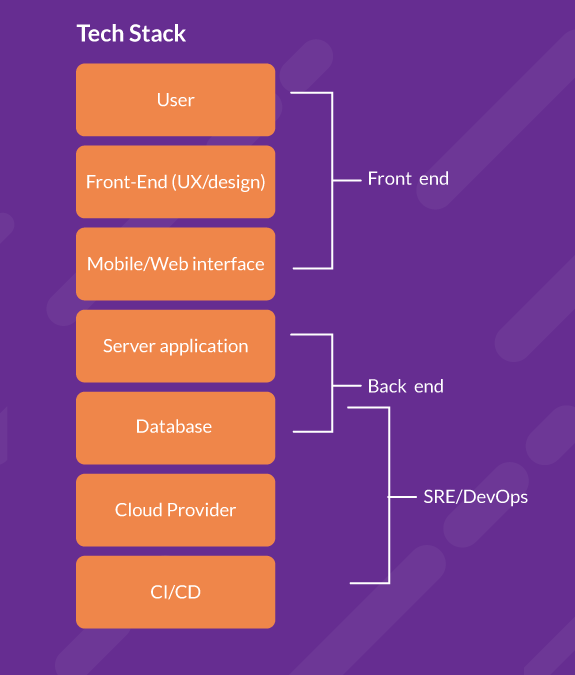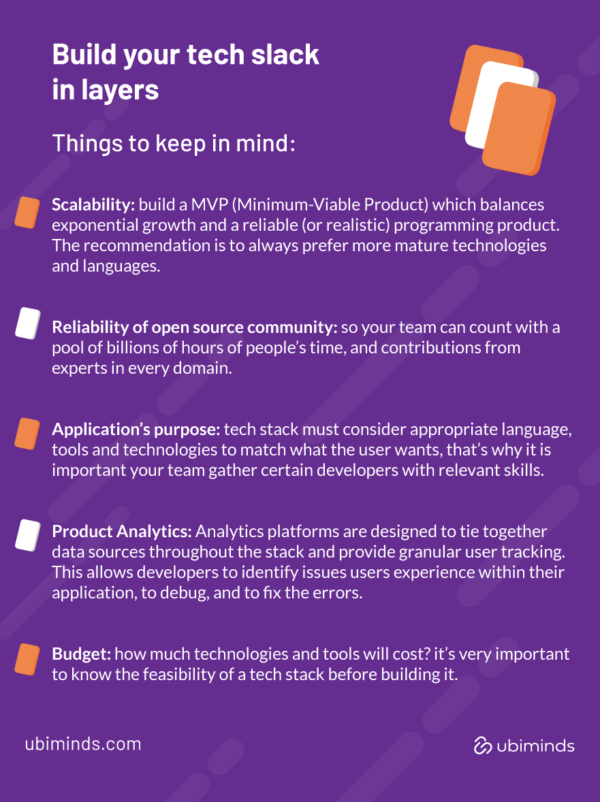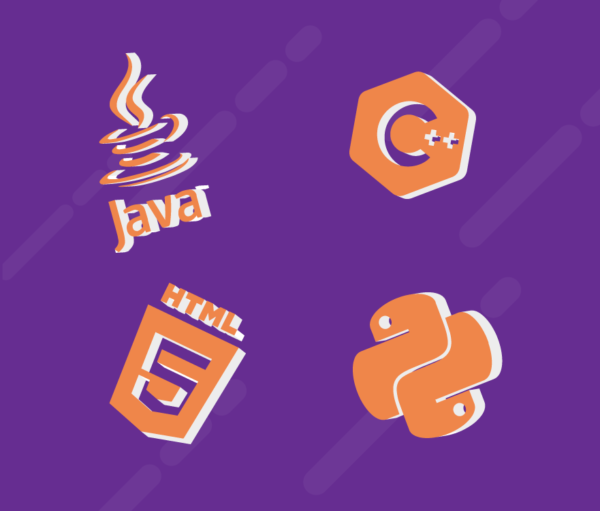Without the right tools and technologies, turning code into a useful product would be an unfeasible task. Software Engineering Tech Stack is a collection of different technologies that work together for some purpose, usually as a foundation for systems such as websites, mobile apps, and standalone desktop software.
LAMP, for example, is a technology stack that stands for Linux (an operation system), Apache (Web server software), MySQL (Database system), and PHP (Programming language).

What is a tech stack? Source: Stack over flow
Software Engineering Tech Stack requires management tools designed to make the engineering work easier: from design and programming the system or application to tests, deployment, and maintenance.
Good tools and technologies are inputs for team performance since they facilitate measuring, reporting, and managing processes at an individual or collective level. When we talk about a technology stack, it involves a data ecosystem that gathers tools, frameworks, and libraries used to build and run applications.
The programming language, the storing code repository (for instance, GitHub, GitLab, BitBucket, etc.) or even using an automation code deployment tool such as CircleCI or monitoring tools (Google Analytics) may influence the performance of your work. So, how do I choose the right tools and technologies based on performance?
How does the tech stack influence software engineering performance?
Depending on the Technology Stack that you choose, the software development performance can be better. It’s crucial to choose a tech stack with technologies that have smooth integrations and a large open-source community so that your development team will be able to draw on others’ knowledge when writing code.
For example, if a desktop or mobile application relies on a local database, the number of input-output transactions on that database will probably not have an appreciable impact on system performance.
Put that database on a local area network or in the cloud, however, and developers have to be much more careful to minimize the number of database calls or the system performance could be dismal.
So when you’re looking into developing a custom application, be it a desktop application, web app, or mobile app, among the first questions the development team should ask you, is what the anticipated technology stack looks like.
Since Tech stack hints at the overall application’s strengths and weaknesses, engineers and developers can know in advance all the attributes and limitations of tools and technologies used in product development. So it’s easier and faster to make a decision.
Another great use for the tech stack is to use it as a basis for hiring new programmers. Once you know in advance what tools and technologies will be used during the Product Development, you’ll need to hire programmers that know them.
Check out some of the impacts in tech stack in software engineering performance:
- Speeds up the programming step. In systems such as websites, especially when database searches are involved, speed is crucial, so all components of the hardware and software stacks should work together to optimize speed performance. Some disk storage components, for example, may be more efficient at writing data than reading it, which would not be a benefit to this type of website application.
- Better Throughput. Some applications might need to do serious number-crunching. This may require a technology stack that is optimized for parallel processing.
- Increases Scalability. Some technology stacks lend themselves more easily to expanding to meet growing demands (such as a number of simultaneous users) by adding disk drives or servers or what have you.
What is the available technology and how to pick your tech stack: Storage, Development / Programming, Deployment, Monitoring, and Analytics, Documentation

Pay attention to Scalability, Reliability of open source community, Application purpose, Product Analytics, and Budget.
Availability means the probability that a system is operational at a given time, for instance, the amount of time a device is actually operating as the percentage of the total time it should be operating.
So building your tech stack in layers always paying attention to:
- Scalability: build an MVP (Minimum-Viable Product) which balances exponential growth and a reliable (or realistic) programming product. The recommendation is to always prefer more mature technologies and languages.
- Reliability of open source community: so your team can count on a pool of billions of hours of people’s time, and contributions from experts in every domain.
- Application’s purpose: tech stack must consider appropriate language, tools, and technologies to match what the user wants, that’s why it is important your team gather certain developers with relevant skills.
- Product Analytics: Analytics platforms are designed to tie together data sources throughout the stack and provide granular user tracking. This allows developers to identify issues users experience within their application, to debug, and to fix the errors.
- Budget: how much technologies and tools will cost? it’s very important to know the feasibility of a tech stack before building it.
It’s a good idea to take a look at the market to understand which tools and technologies bring the most benefits possible. A list of most popular Software Development Technologies from Pluralsight includes:
- Java
- Javascript
- HTML
- C
- Git
- C++
- Python
- CSS
- Blockchain
- SQL
Besides these, here is another shortlist of popular categories when considering your tech stack:
- Popular operating systems: Linux, iOS, Android
- Servers and load balancing: AWS, Google Cloud, Azure, Apache, Nginx, Cloudflare, Fastly
- Data storage and querying: MySQL, Azure SQL Synapse Analytics, MongoDB, Redshift, PostgresSQL, Snowflake, Splunk, Talend, Fivetran
- Backend Frameworks: Ruby on Rails, Django, Laravel, Spring, .NET
- Frontend frameworks and tools: AngularJS, React, Bootstrap, jQuery, Emberjs, Backbonejs
- Popular API platforms: Segment, Google Apigee, Mulesoft, Tealium, Zapier
- Monitoring and performance tools: New Relic, AppDynamics, Dynatrace, Datadog
- Business intelligence solutions: Microsoft Power BI, SAP BusinessObjects, Tableau, Looker, Qlik
- Behavioral and product analytics: Heap, Google Analytics, Amplitude, Mixpanel, Countly
Call in the performance engineers: Reasons why you should have experts helping you choose and implement your tech stack
Do you know the expression: “fail fast, learn faster”? In fact, it’s more to “go wrong, but be careful what it will cost”.
It’s not a secret that the cost of software development has always mattered and influenced the way we create things in a technology company, right?
So, conducting effective performance engineering activity optimizing the use of existing resources to ensure long-term savings must be our goal since the beginning. And, what is the most guaranteed way to make fewer mistakes or to get as close to not making mistakes?
Yes, hiring highly skilled individuals who can quickly understand the application architecture blueprint, technology stack, deployment topology, and possible issues and challenges in implementation.
Doing that, you ensure:
- Speed to dissect the problem and provide valid inputs to multiple teams for faster resolution
- Setting right SLA’s, having a view on the possible usage of the application to help engineer architect the test with right scenarios and business conditions
- Providing current usage patterns and future scalability needs for conducting the right benchmark tests and capacity planning.
- Dealing with Complexities more easily since seniors tend to apply rights methods for development and deployment such as image optimization, JavaScript and CSS minification, compression and caching, reducing performance bottlenecks
Curious about how you can improve people management in your engineering team? Talk to Ubiminds
Ubiminds combines the best of each world when it comes to growing your software business. Ubiminds also supports People Management in the software engineer team acting as a boutique agency for filling Principal and Lead positions (as well as other leadership roles) but has a facilitated engagement model so you can upscale and downscale teams quickly.
Stop wasting time tight now and starting focus on product development, not hiring processes. Let Ubiminds spare you 75% of the work!

International Marketing Leader, specialized in tech. Proud to have built marketing and business generation structures for some of the fastest-growing SaaS companies on both sides of the Atlantic (UK, DACH, Iberia, LatAm, and NorthAm). Big fan of motherhood, world music, marketing, and backpacking. A little bit nerdy too!






